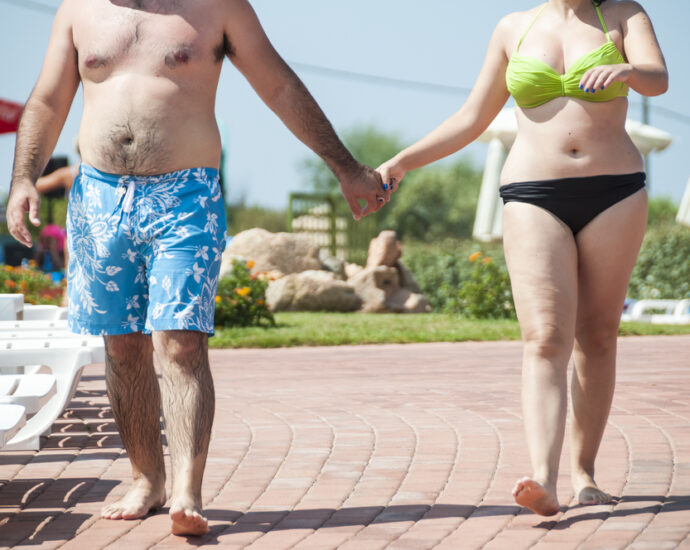Stubborn body fat presents challenges for both men and women. The distribution and persistence of fat deposits often differ between the sexes due to hormonal, genetic and physiological factors. Gaining an appreciation for these gender-specific challenges can be very constructive when it comes to tailoring effective fat loss strategies. Below, we’ll briefly go over the differences and how to address stubborn body fat.
Naturally, hormonal variations play a significant role in the differences between the sexes. Men typically possess higher levels of testosterone, promoting more visceral fat storage in the abdominal region. Conversely, women tend to have higher levels of estrogen, which leads to increased subcutaneous fat storage around the hips, thighs and buttocks. These common problem areas can also be affected by lifestyle choices, such as poor dietary habits and insufficient exercise. Alcohol consumption and genetics can also play a part in fat accumulation.
How can both men and women lose fat in problem areas? While many instinctually opt for spot reduction, losing weight in specific areas through targeted exercises is a myth. Rather, adopting a comprehensive approach to weight loss and maintaining overall health is the key to reducing fat throughout the body, including problematic areas.
Applying this holistic strategy encompasses various elements with a balanced diet forming the foundation. Incorporating whole foods like fruits, vegetables, lean proteins and healthy fats while also limiting processed foods, sugary snacks and excessive carbohydrates is essential. So too is drinking plenty of water throughout the day as proper hydration supports metabolism.
Stress management also plays a significant role as chronic stress can lead to weight gain and retention of stubborn fat. Incorporating stress-reducing activities such as yoga, meditation or deep breathing exercises into daily routines can mitigate its impact. Of course, working out is essential. A person’s regular exercise should cover a mix of cardiovascular, flexibility and strength training. Cardio activities such as running, cycling and swimming help burn calories and improve heart health, while strength training builds muscle mass and boosts metabolism.
High-intensity interval training (HIIT) can also be beneficial, especially for men. These involve short bursts of intense exercise followed by brief rest periods and are effective for burning calories and reducing body fat. Furthermore, anyone pursuing fat loss should ensure they’re getting adequate sleep. Poor sleep habits can disrupt certain hormones involved in appetite regulation and metabolism, making it more difficult to reach weight loss goals.
Stubborn body fat often leads individuals to explore aesthetic treatments such as liposuction or Smartlipo or CoolSculpting for targeted fat reduction. Smartlipo employs a minimally invasive surgical technique to precisely target and remove fat cells from the body, effectively sculpting and contouring specific areas. In contrast, CoolSculpting offers a non-invasive approach by freezing and eliminating fat cells through controlled cooling, resulting in gradual and natural fat reduction without the need for surgery or incisions. CoolSculpting can treat many areas of the body such as the abdomen, upper arms, waist, love handles, flanks, muffin top, inner and outer thighs, back fat, bra roll, under chin and gynecomastia.
Hormone Replacement Therapy (HRT) and weight loss injections are also strategies for individuals grappling with stubborn body fat – particularly when hormonal imbalances are at play. HRT involves supplementing or replacing deficient hormones in the body with synthetic hormones. For instance, women undergoing menopause may opt for estrogen or progesterone replacement therapy to counteract symptoms like weight gain and stubborn fat accumulation around the midsection. Similarly, men with low testosterone levels might turn to testosterone replacement therapy to support muscle development and fat loss.
Weight loss injections like semaglutide increase insulin production, decrease glucagon synthesis, delay gastric emptying and suppress hunger. It signals your brain that you are full so you can lose weight without feeling like you are depriving yourself. These injections – administered under medical supervision – are frequently part of a comprehensive weight loss plan integrating dietary adjustments, lifestyle modifications and regular exercise routines.
These options can offer impressive results, however, it’s necessary to consult with a health care provider to assess candidacy and understand associated risks. Incorporating such treatments into a holistic weight loss approach can be very beneficial in reaching aesthetic and wellness goals.
Want to learn more about the dilemma of stubborn body fat and how it affects women versus men? Check out the accompany resource from Young Medical Spa for further information.

Infographic provided by Young Medical Spa, a provider of smartlipo laser assisted liposuction
Resources
https://www.ncbi.nlm.nih.gov/pmc/articles/PMC6906176/
https://www.anxiety.org/nutrition/weight-management/how-to-lose-body-fat-men-methods-tips
https://www.medicalnewstoday.com/articles/249908#1
https://www.prevention.com/weight-loss/g20438900/hormones-causing-your-belly-fat/
https://youngmedicalspa.com/services/body-sculpting-shaping/
